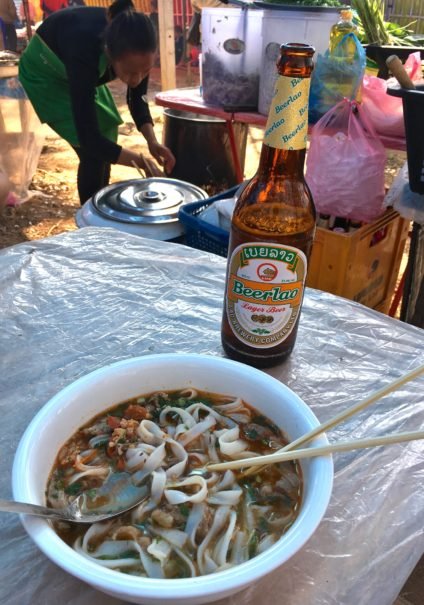
Perhaps the Longest, Most Awkward New Year’s Party in the World

Perhaps the Longest, Most Awkward New Year’s Party in the World
Beerlao in Laos
High in the jungle of northern Laos, a rooster’s cry mingled with the thump of a bass that threatened to blow out the town’s only speakers. I’d arrived in a village of the ethnic minority Hmong group after trekking through the mountains for hours, just in time to celebrate the start of their new year with an all-night dance party.
The locals had toiled in the glaring heat on steeply sloping fields throughout the year to harvest their crops, and now I, too, was able to savor the fruits of their labor. I cradled a warm Beerlao, made from hops picked nearby, enjoying the crisp national brew in the remote and dusty town. The locals favored a cheaper alternative: half a dozen men sat in a circle on the ground, sipping homemade whiskey from a large jar through meter-long straws.
I watched other revelers swaying under a blue-and-white striped tarpaulin, where the makeshift dance floor was lit by a single fluorescent bulb.
“Is this a traditional dance?” I asked a young Hmong man, gesturing toward the crowd. The dancers shuffled around the perimeter of the venue, rocking almost imperceptibly from side to side and holding their hands limply at waist-level like an army of hamsters.
“No,” he said firmly.
Yet what was not a customary or inspiring dance was certainly an effective way to conserve energy, and soon the purpose of their endurance-focused circumambulations revealed itself. Throughout the night, the people danced in the light of bonfires and drank among howling dogs as Thai disco and Lao pop ballads pierced the walls of the village’s small bamboo houses, fueling a raging party until the speaker batteries finally ran out as the sun came up.
But that night turned out to be only a prelude to the biggest party of the year. Two days later, roughly 1,000 people from Hmong villages all over the region streamed down from the hills to celebrate together and meet new romantic partners in a wooded area on the outskirts of Luang Prabang.
The Hmong new year is a matchmaking extravaganza, where men are known to spend most of their year’s salary in the 10 days of the festival. Hmong families play carnival games, watch beauty pageants, and take glamor shots against painted scenic backdrops during a party that doubles as the ultimate speed-dating. Adolescents are primped, preened, and sent in their finest traditional costumes to the festival, where they squirm under the pressure of a year’s worth of anticipation.
One way to get the conversation flowing is a game called pov pob. Young men and women stand shoulder-to-shoulder in lines opposite one another and throw a small cloth ball back and forth in a courting ritual that elicits as much blushing and whispering as any slow song at a middle school dance.
Watching the scene unfold filled me with the dread of a pubescent, feeling by proxy the universal agony of attraction and repulsion in teenage love on full display for families and friends. It was a ritual they would repeat for 10 days, from morning to midnight.
The thought sent me straight back to the line for Beerlao.